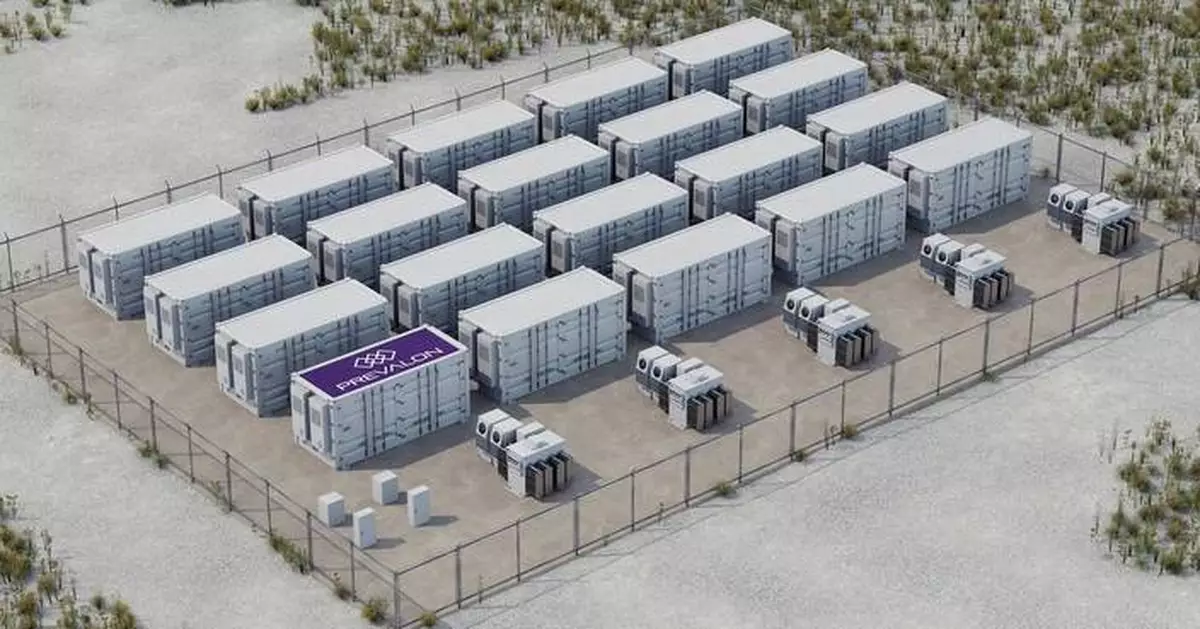HEATHROW, Fla.--(BUSINESS WIRE)--Mar 29, 2024--
Prevalon Energy LLC, a Mitsubishi Power Americas company, announces it has contracted with Idaho Power for a complete Battery Energy Storage System (BESS) along with a robust long-term service agreement. The project will provide grid resiliency as a net peak solution, helping the utility continue providing reliable power during peak demand periods. The service agreement includes maintenance as well as remote monitoring.
This press release features multimedia. View the full release here: https://www.businesswire.com/news/home/20240329763704/en/
The four-hour battery storage project with up to 328 MWh from Prevalon will align with Idaho Power’s plan to integrate more than 5,000 megawatts (MW) of energy from wind and solar projects over the next 20 years. The BESS will ensure energy produced by those intermittent sources can be stored for future dispatch. The company’s “Prevalon Battery Energy Storage Platform,” a complete AC solution including the battery enclosures, inverters, medium voltage transformers and EMS (Energy Management System), will be the cornerstone of the utility’s battery storage project, which will make a significant contribution to Idaho Power’s goal of providing 100% clean energy by 2045. The BESS from Prevalon is designed to meet the utility’s specific needs, including robust safety and security protocols and reliable operations. The project is expected to be fully operational in 2025.
“This order is a testament to the hard work of a very talented team that has positioned Prevalon as a skilled and established business partner for our customers with deep project experience in the fast-moving and growing development of battery energy storage,” said Prevalon President and CEO Tom Cornell. “We place high value on the partnering mindset and are looking forward to working closely with Idaho Power as they incorporate our end-end integrated battery energy storage solution into their long-range plans to ensure a stable and reliable energy grid for their customers.”
Battery energy storage has emerged as a critical technology in the march toward a cleaner, sustainable energy future. Prevalon is committed to innovating battery energy storage products and services to store electrical energy, much of it from renewable sources such as wind and solar, so that it can be utilized at a later time. This approach enables a more efficient, reliable, and sustainable electricity grid as it is designed to respond quickly to grid demand and supply changes.
About Prevalon Energy LLC
Commitment, reliability, expertise. These are the ideals that guide our decision making, design philosophy, and relationship building. Prevalon Energy LLC (Prevalon), a Mitsubishi Power Americas Company, is empowering companies to deploy flexible energy solutions and accelerate a more sustainable energy future. With 10 years of global battery energy storage experience and over 3 GWh of utility-scale battery energy storage projects deployed, Prevalon develops an end-to-end integrated battery energy storage solution that delivers throughout the entire lifecycle of your project and ensures performance. From design and engineering, energy management systems integration, commissioning, and long-term service programs, the Prevalon Battery Energy Storage Platform meets the demands of your energy system today and into the future. For more information, visit PrevalonEnergy.com and follow us on LinkedIn.
About Idaho Power
Idaho Power, headquartered in vibrant and fast-growing Boise, Idaho, has been a locally operated energy company since 1916. Today, it serves a 24,000-square-mile area in Idaho and Oregon. The company’s goal to provide 100% clean energy by 2045 builds on its long history as a clean-energy leader that provides reliable service at affordable prices. With 17 low-cost hydroelectric projects at the core of its diverse energy mix, Idaho Power’s residential, business and agricultural customers pay among the nation’s lowest prices for electricity. Its 2,100 employees proudly serve more than 630,000 customers with a culture of safety first, integrity always and respect for all.
IDACORP Inc. (NYSE: IDA), Idaho Power’s independent publicly traded parent company, is also headquartered in Boise, Idaho. To learn more, visit idahopower.com or idacorpinc.com.


Prevalon and Idaho Power plan to bring critical reliable power needed during peak demand periods to bolster grid resiliency. The project will provide up to 328MWh’s. (Rendering Credit: Prevalon)
DJENNE, Mali (AP) — Thousands of Malians carrying buckets and jugs of mud joined the annual replastering of the world's largest mud-brick building this weekend, a key ritual that maintains the integrity of the Great Mosque of Djenne in the center of the country.
The building has been on UNESCO’s World Heritage in Danger list since 2016. The mosque and surrounding town, a historical center of Islamic learning, have been threatened by conflict between Islamist rebels, government forces and other groups.
Djenne’s mosque requires a new layer of mud each year before the rainy season starts in June, or the building will fall into disrepair. The replastering event once drew tens of thousands of tourists each year. As with the rest of Mali, Djenne’s tourism industry has all but completely disappeared.
“The plastering of the mosque is a symbol of peace. The poor, the rich, everyone is here for this activity." Amadou Ampate Cisse, a Djenne resident taking part in the event, told The Associated Press: "We will continue this tradition from generation to generation. We will pass it on to our children and they in turn will do the same.”
Traditionally, women and girls fetch water from the nearby river to mix with clay to make the mud, and men and boys climb the mosque and apply the new layer.
Moussa Moriba Diakité, head of Djenne’s cultural mission, said insecurity has threatened the annual event. “A lot of people talk about insecurity, and we hear that we can’t come to Djenne because there is insecurity,” he said.
Despite the disappearance of Djenne's tourism industry, the maintenance of the mosque is something that must continue “at any cost," Diakité said, to preserve the country’s cultural heritage.
Mali, along with its neighbors Burkina Faso and Niger, is battling an insurgency by armed groups, including some allied with al-Qaida and the Islamic State group. Following military coups in all three nations in recent years, the ruling juntas have expelled French forces and turned to Russia’s mercenary units for security assistance.
The Associated Press receives financial support for global health and development coverage in Africa from the Bill & Melinda Gates Foundation Trust. The AP is solely responsible for all content. Find AP’s standards for working with philanthropies, a list of supporters and funded coverage areas at AP.org.

The world's largest mud-brick building, the Great Mosque of Djenne, Mali, awaits its annual replastering, Friday, May 10, 2024. The building has been on UNESCO's World Heritage in Danger list since 2016. The mosque and surrounding town are threatened by conflict. Djenne's mosque requires a new layer of mud each year before the start of the rainy season in June. (AP Photo/Moustapha Diallo)

Malians take part in the annual replastering of the world's largest mud-brick building, the Great Mosque of Djenne, Mali, Sunday, May 12, 2024. The building has been on UNESCO's World Heritage in Danger list since 2016. The mosque and surrounding town are threatened by conflict. Djenne's mosque requires a new layer of mud each year before the start of the rainy season in June. (AP Photo/Moustapha Diallo)

Malians take part in the annual replastering of the world's largest mud-brick building, the Great Mosque of Djenne, Mali, Sunday, May 12, 2024. The building has been on UNESCO's World Heritage in Danger list since 2016. The mosque and surrounding town are threatened by conflict. Djenne's mosque requires a new layer of mud each year before the start of the rainy season in June. (AP Photo/Moustapha Diallo)

Malians gather at the foot of the Great Mosque of Djenne, Mali, joining in for the annual replastering of the world's largest mud-brick building, Sunday, May 12, 2024. The building has been on UNESCO's World Heritage in Danger list since 2016. The mosque and surrounding town are threatened by conflict. Djenne's mosque requires a new layer of mud each year before the start of the rainy season in June. (AP Photo/Moustapha Diallo)

Malians take part in the annual replastering of the world's largest mud-brick building, the Great Mosque of Djenne, Mali, Sunday, May 12, 2024. The building has been on UNESCO's World Heritage in Danger list since 2016. The mosque and surrounding town are threatened by conflict. Djenne's mosque requires a new layer of mud each year before the start of the rainy season in June. (AP Photo/Moustapha Diallo)

Malians take part in the annual replastering of the world's largest mud-brick building, the Great Mosque of Djenne, Mali, Sunday, May 12, 2024. The building has been on UNESCO's World Heritage in Danger list since 2016. The mosque and surrounding town are threatened by conflict. Djenne's mosque requires a new layer of mud each year before the start of the rainy season in June. (AP Photo/Moustapha Diallo)

Malians take part in the annual replastering of the world's largest mud-brick building, the Great Mosque of Djenne, Mali, Sunday, May 12, 2024. The building has been on UNESCO's World Heritage in Danger list since 2016. The mosque and surrounding town are threatened by conflict. Djenne's mosque requires a new layer of mud each year before the start of the rainy season in June. (AP Photo/Moustapha Diallo)

Malians take part in the annual replastering of the world's largest mud-brick building, the Great Mosque of Djenne, Mali, Sunday, May 12, 2024. The building has been on UNESCO's World Heritage in Danger list since 2016. The mosque and surrounding town are threatened by conflict. Djenne's mosque requires a new layer of mud each year before the start of the rainy season in June. (AP Photo/Moustapha Diallo)



















